Sights of Vladimir
Around Sobornaya Ploschad
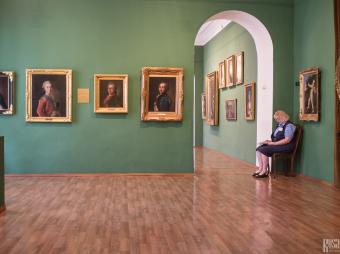
'Palaty' Cultural Educational Centre
- Sobornaya Ploschad, 58 Ulitsa Bolshaya Moskovskaya
- http://www.vladmuseum.ru/eng/
- 10:00 - 17:00 (Tuesdays and Wednesdays: 10:00 - 16:00). Closed on Mondays and the last Thursday of the month.
The 'Palaty' Cultural Education Centre is located in what was once the city's public office. It is now part of the Vladimir-Suzdal Museum Reserve and comprises a museum centre especially for children, which has many thematic displays with titles such as 'An Old Russian School', 'A Trip to the Stone Age', 'A Walk around the Old City' and 'A Russian House' among others. For the adults there is also an art gallery and an exhibition centre. Read more »
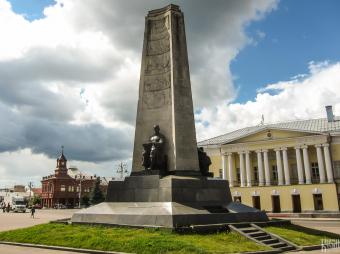
850th Anniversary of Vladimir Monument
- Sobornaya Ploschad
The foundations for this monument were laid in 1958 to commemorate the 850th anniversary of Vladimir (then it was considered that the city was founded in 1108). It comprises a concave three-sided obelisk with a statue on each side. The first is of an ancient warrior facing the Golden Gates, the second is of an architect facing the Dormition Cathedral and the final one is of a modern-day worker facing the industrial sector of the city. Read more »
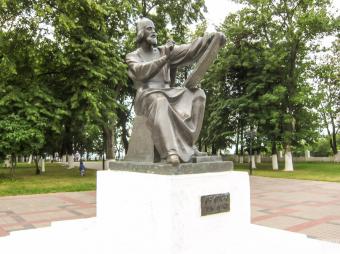
Andrey Rublev Monument
- Sobornaya Ploschad
Located at the entrance of Pushkin park is a monument of Andrey Rublev, Russia's most famous icon painter. The statue was unveiled in 1995 as part of the city's millennium celebrations (based on the revaluation of the date of foundation) and is the work of the well-known sculptor Oleg Komov. The statue is close to the Dormition Cathedral, which Rublev himself had a hand in decorating. Read more »
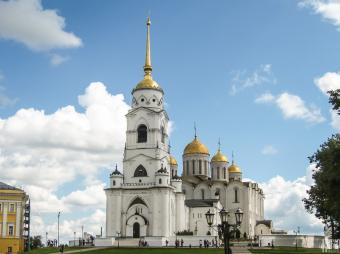
Dormition Eparchial Cathedral
- Sobornaya Ploschad, 54 Ulitsa Bolshaya Moskovskaya
- http://www.vladmuseum.ru/eng/
- 13:00 - 16:45. Closed on Mondays. Also open for worship at other times.
One of the most famous white-stone buildings of pre-Mongol Russia is Vladimir's Dormition Cathedral. The original version of the cathedral was built between 1158 and 1160 on the orders of Andrey Bogolyubsky to hold the Our Lady of Vladimir Icon, which he had brought with him from Vyshhorod. This original version burned down in 1185 although the icon miraculously survived. The cathedral was rebuilt between 1186 and 1189 by Vsevolod the Big Nest as a six-pillar five-dome building,… Read more »
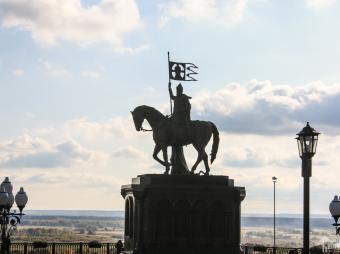
Prince Vladimir and St Theodor Monument
- Sobornaya Ploschad
Also located on Sobornaya Ploschad close to the Dormition Cathedral is a monument to Prince Vladimir the Great. Prince Vladimir was prince of Kiev from 980 to 1015 and was responsible for Rus giving up the pagan religion for Christianity. Prince Vladimir is depicted on horseback flying a banner with Christ's image. Next to him stands St Theodor (Fyodor) who assisted him in his mission to baptise Rus. Read more »
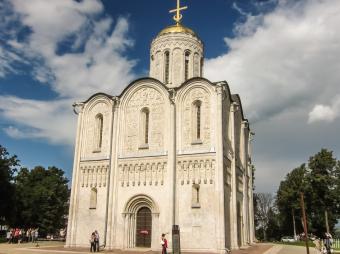
St Demetrius' Cathedral
- Sobornaya Ploschad, 60 Ulitsa Bolshaya Moskovskaya
- http://www.vladmuseum.ru/eng/
- 11:00 - 18:00 (Mondays and Wednesdays: 11:00 - 17:00). Closed Tuesdays and the last Wednesday of the month. In winter it opens and closes an hour earlier.
St Demetrius' Cathedral was built on the orders of Vsevolod the Big Nest between 1194 and 1197 to serve as his court's church. It is dedicated to the martyr St Demetrius of Thessaloniki (Saloniki), whose name Vsevolod took when he was christened. In form it is the standard white-stone four-pillar single-dome structure, but stands out due to its stunning stone carvings of patterns, saints and real and mythical beasts. Inside some fragments of 12th century frescos remain. In 1992 the… Read more »
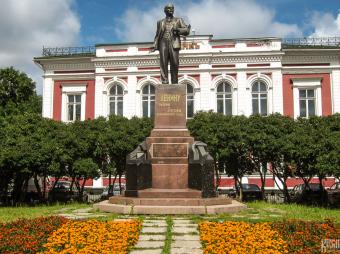
Vladimir Lenin Monument
- outside 29 Ulitsa Bolshaya Moskovskaya
This statue of Lenin has stood here since 1950 when it replaced a previous Lenin statue which was unveiled in 1925. The current statue depicts Lenin with one hand holding onto his jacket and one hand by his side, whereas previously he was pointing towards the Dormition Cathedral. The pedestal where Lenin now stands was once occupied by a statue of Emperor Alexander II. Behind the statue is the city bank which was built in 1896. Read more »
Around the Golden Gates
Archangel Michael’s Church
- 1A Studenaya Gora
Archangel Michael's Church was built in 1893 using the funds left for this purpose in the will of a local merchant. It is rather unusual among Vladimir's churches. Constructed out of red bricks, it takes the form of a tower church with a dome standing on top of a hexagonal structure with curved domes. Closed in 1929, it later housed exhibitions until it was re-consecrated in 1997. Next to the church is a bell tower and a separate chapel. Read more »

Ascension Church
- 14A Ulitsa Voznesenskaya
The Ascension Church dates from 1724 but a church dedicated to the Ascension of Christ has stood here since at least 1187. Then it was part of a monastery which was most likely founded by Andrey Bogolyubsky. In 1813 a bell tower was added in commemoration of the victory over Napoleon. The church was closed by the Soviets in 1934 and only re-consecrated as a parish church in 1990. Read more »

Church Ensemble on Spasskaya
- 8 Ulitsa Spasskaya
The church ensemble at Ulitsa Spasskaya comprises a cold church which is used in summer and a warm church which is used the winter. The Transfiguration of the Saviour Church is the ensemble's cold church. It was built in 1778 and is rather standard in style. Immediately next to this is the St Nicholas' Church, the ensemble's warm church. It dates from 1699 and is much prettier than its younger neighbour with a small single domed structure attached to a bell tower. Read more »

Crystal, Lacquered Miniatures and Embroidery Exhibition
- 2 Ulitsa Dvoryanskaya
- http://www.vladmuseum.ru/eng
- 11:00 - 19:00. Closed on Tuesdays and the last Wednesday of the month.
The Trinity Old-Believers Church was completed in 1913 to commemorate the 300th anniversary of the reign of the Romanovs. It is built in the Russian revival style and is often called the red church due its colour. It was closed in 1928 and since 1974 has housed an exhibition dedicated to crystal, lacquered miniatures and embroidery. On display are examples of the applied art which was traditionally produced in the lands around Vladimir. The exhibition is run as part of the Vladimir… Read more »

Golden Gates
- beginning of Ulitsa Bolshaya Moskovskaya
- http://www.vladmuseum.ru/eng
- 10:00 - 18:00. Closed on Thursdays and the last Friday of the month.
The Golden Gates were built between 1158 and 1164 on the orders of Andrey Bogolyubsky to serve as the main entrance into the city. Now the gates have become a symbol of the city. Originally the city was completely surrounded by earthen mounds and in addition to the Golden Gates there were another four sets of gates, but these have not survived. Most of the earthen mounds were flattened in 1778 as part of the new regulated city plan. Around this time the Deposition of the Robe… Read more »
Holy Rosary Catholic Church
- 12 Ulitsa Gogolya
- http://hram-vladimir.ru
Vladimir's only catholic church - the Holy Rosary Catholic Church - was built between 1892 and 1894 in the Russian gothic style. In 1930 the church was closed and during the Soviet period its bell tower was used as a radio transmitter and in the 1970s its building was used as an exhibition hall. It was returned to the Catholic Church In 1992 and became part of the recently established Roman Catholic Archdiocese of Moscow. Read more »

Knyaginin Uspensky Convent
- 37A Pereulok Vorovskogo
The Knyaginin Convent was first mentioned in 1200 and was founded around this time by Maria Shvarnovna who was the first wife of Grand Prince Vsevsolod the Big Nest of Vladimir. Its name is derived from the Russian word for princess ('knyagina') and the Russian word for the Dormition ('Uspenie') of the Virgin Mary, to which is it dedicated. Maria Shvarnovna was laid to rest in the convent and later other princesses were also buried here. The convent was sacked during the Tatar raid… Read more »

Old Vladimir Exhibition (Water Tower)
- Ulitsa Kozlov Val
- http://www.vladmuseum.ru/eng/
- 10:00 - 18:00. Closed on Mondays and the last Wednesday of the month.
Occupying four floors of an old water tower is the Old Vladimir Exhibition which has displays on the history of the city from the end of the 19th century to the beginning of the 20th century. The first floor concerns the city and its streets and buildings, the second floor the citizens and the third floor the spiritual life of the city. A viewing platform is located on the fourth floor from where you can enjoy great views of the cathedrals on Sobornaya Ploschad and the land on the… Read more »

St George’s Church
- 2A Ulitsa Georgievskaya
In 1157 Prince Yuri Dolgoruky had a church built here and dedicated it to his protector St George. However this version of the church burned down in 1778 and was replaced in 1796. The new version was built in the baroque style with a decorated cube structure with a single dome attached to a tent-domed bell tower. The church was closed in 1980 and at one point its premises were used for smoking sausages which caused the church's frescos to be covered with a layer of fat. Later the… Read more »

St Nicetas the Martyr’s Church
- 8 Ulitsa Knyagininskaya
Located just outside the Knyaginin Uspensky Convent is St Nicetas the Martyr’s Church, which stands out among Vladimir's churches due to its large scale. It comprises a three-storey building with a dome and a bell tower on top. It is also pretty in appearance coloured green with white window frames. It was built in 1765 on the orders of a local merchant. The church was closed in 1937 and since the 1970s it has housed the planning department of the Vladimir restoration workshop. … Read more »
St Nicholas' Galley Church
- 26 Ulitsa Nikolo-Galeyskaya
This church is called the St Nicholas' Galley Church to distinguish it from other churches dedicated to St Nicholas in the city. It is located where there was once a prier which is how it got its name from the type of trading ship which were used by traders and travellers. It was built in 1735 and is a 'ship' church in form with a hexagon-on-cube structure attached to a bell tower via a closed vestibule. Read more »
Around Ulitsa Bolshaya Moskovskaya
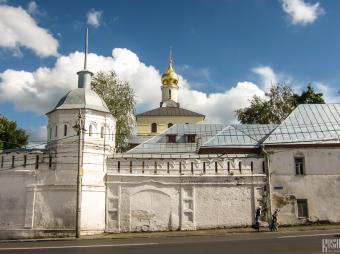
Bogoroditse-Rozhdestvensky Monastery
- 68-70 Ulitsa Bolshaya Moskovskaya
The Bogoroditse-Rozhdestvensky Monastery was founded in 1191 by Grand Prince Vsevolod the Big Nest of Vladimir and is dedicated to the Nativity ('Rozhdestvo') of the Virgin Mary ('Bogoroditsa'). During the Mongol-Tatar invasion in 1237 the monastery was sacked and all its monks were killed. In 1263 the body of Andrey Nevsky was originally interred here but moved to St Petersburg in 1723. In 1744 the monastery became a residence for the Archbishop of Vladimir and Suzdal. It was… Read more »
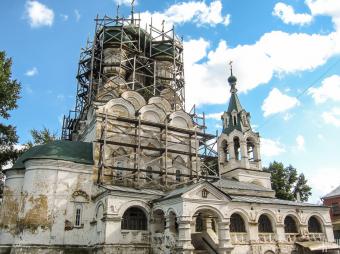
Dormition Old-Believers Church
- 106A Ulitsa Bolshaya Moskovskaya
One of the most beautiful and decorative churches in Vladimir is the Dormition Church. It was built in 1649 using the funds of Vladimir's successful craftsmen and merchants to replace an older wooden version which had been destroyed by fire. In form it includes a bell tower and a closed gallery. The main building of the church is topped with five green domes and beneath them it is decorated with three rows of kokoshniks. Closed during the Soviet times, in the early 1990 it was… Read more »
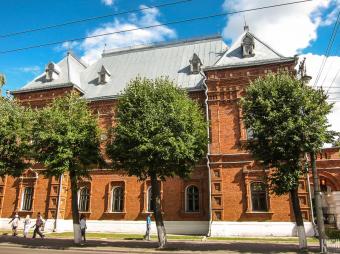
History Museum
- 64 Ulitsa Bolshaya Moskovskaya
- http://www.vladmuseum.ru/eng/
- 10:00 - 17:00 (10:00 - 16:00 on Mondays and Thursdays), closed on Tuesdays and the last Thursday of the month.
The History Museum of the Vladimir-Suzdal Museum Reserve is dedicated to the history of Vladimir lands from the stone age until the Russian revolution. Among its displays it includes information on the Sungir archaeological site near Vladimir where an Upper Palaeolithic grave was discovered, the Mongol-Tatar Invasion and everyday life in the city throughout the ages. Read more »
St Nicholas’ Kremlin Church and Aleksandr Nevsky Monument
- 66A Ulitsa Bolshaya Moskovskaya
This pretty yellow St Nicholas' Church is known as the Kremlin Church due to its location inside the old kremlin and to distinguish it from other churches in the city dedicated to St Nicholas. The church dates from 1761. Currently the church houses a planetarium although there are plans to return it to its original purpose. Outside the church is a statue of Aleksandr Nevsky. Read more »
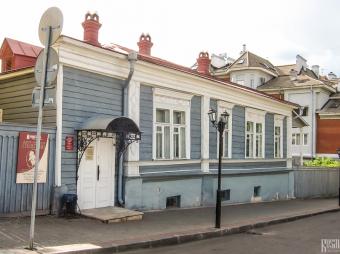
Stoletov House-Museum
- 3 Ulitsa Stoletovykh
- http://www.vladmuseum.ru/eng/
- 10:00 - 17:00 (Tuesday and Sundays: 10:00 - 16:00). Closed on Thursdays and the last Friday of the month.
The Stoletov House-Museum is dedicated to the brothers Nikolai and Aleksandr Stoletov who were both born in Vladimir and grew up in the house which is now occupied by the museum. Nikolai was a general who became famous during the Russo-Turkish War of 1877-1878 and Aleksandr was a physicist and a professor at Moscow State University. The interior of the house has been preserved to show a typical late 19th century merchant's house. The house-museum is part of the Vladimir-Suzdal… Read more »
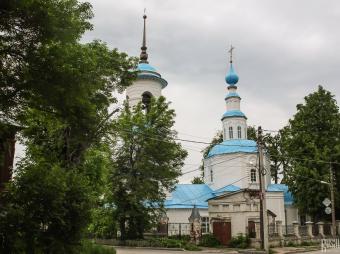
Trinity Church
- 8 Ulitsa Muzeynaya
The Trinity Church was completed in 1740 and was built in the standard octagon-on-cube form to replace an earlier version which was destroyed by fire in 1719. A bell tower was added several years later in 1746 and attached to the main part of the building via a closed vestibule. A painting of the Holy Trinity decorates the bell tower. Some of the small towers of the church's original fencing still remain. Read more »
Out of the Centre
Aleksievsky Konstantino-Yeleninsky Monastery
- 8 Konstantino-Yeleninsky Proezd
The Alekievsky Konstantino-Yeleninsky Monastery was founded in 1362 by Bishop Alexius (Aleksi) in the village of Dobry which has since been incorporated into the city of Vladimir. Bishop Alexius later went on to become Metropolitan of Kiev and All Rus (the first to move to Moscow) and a saint. The monastery was closed during the Soviet era when it was used as a factory and it was only reopened in 2003. Its main church is the Ss Constantine and Helena’s Church which dates from 1770… Read more »
Prince Vladimir’s Church
- 71A Ulitsa Bolshaya Nizhegorodskaya
Prince Vladimir's Church is a pretty yellow church dating from 1785. It is built in the 'ship' style with a small single domed structure attached to a bell tower via a closed vestibule. The church is located in Knyaz-Vladimirskoe Cemetery which was established in the 1770s after Catherine the Great enacted laws banning the burial of people in city parish churches. People buried in the cemetery include those killed in the First World War, the Russian Civil and the Second World War,… Read more »

Victory Memorial
- Ploschad Pobedy (intersection of Prospekt Lenina and Ulitsa Chaikovskogo)
Ploschad Pobedy (Victory Square) is off Prospekt Lenina and as you would expect from its name a war memorial is located here. The memorial was opened in 1967 and then only included the eternal flame and the memorial plinths. A statue of a mother, a soldier and a home-front worker were added in 1985. To make space for the square the Our Lady of Kazan Church was demolished in 1966, but this church has since been rebuilt behind the memorial. Read more »


 History
History